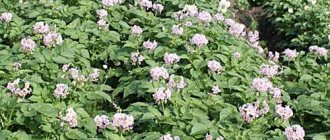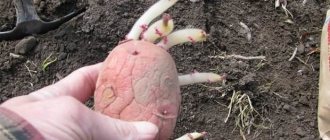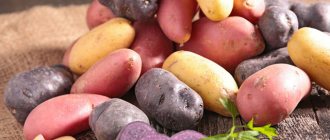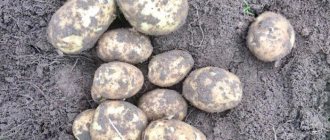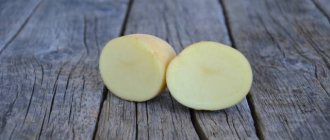Potatoes are the most common vegetable in our country. It is grown in almost every area. Therefore, every gardener wants to choose the most productive and tasty variety for himself. Breeders, knowing this, are constantly developing and improving potato varieties. Every year there are more and more of them. With such variety, it is difficult to determine the best option. In this article we will look at one of the favorite varieties of many gardeners - “Breeze”. Below you will see detailed characteristics of the Breeze potato variety.
Breeze potato planting dates
This potato variety is planted, like all others, when the soil warms up to 10 degrees. This usually happens at the end of April-May. You can plant it earlier, but potatoes will sprout only in warm soil.
Some gardeners advise germinating potatoes before planting, then they will take root in the ground faster. To sprout potatoes, 20 days before planting, lay them out in a warm room and spray them with water, turning them over occasionally.
Plant Breeze potatoes in pre-prepared holes. It is recommended to dig up the soil in the fall and apply fertilizer. But if this was not done in the fall, you can apply fertilizer to each hole in the spring immediately before planting.
Potatoes are planted at a depth of 10 cm, the distance between holes is 30 cm, and between rows 70.
Story
Breeze is a potato variety (Solanum tuberosum) of Belarusian selection, ripening in the mid-early period.
Developed by the staff of the Scientific and Practical Center of the National Academy of Sciences of Belarus for potato and fruit and vegetable growing. Added to the state register of varieties of the Russian Federation in 2009, to the state register of the Republic of Belarus - in 2006. Zoned in the Central (Bryansk, Vladimir, Ryazan, Smolensk, Ivanovo, Kaluga, Moscow and Tula regions) and Northwestern (Vologda, Kaliningrad, Pskov, Tver, Yaroslavl, Kostroma, Leningrad and Novgorod regions) regions of Russia.
Authors: B.S. Tolkachev, V.L. Makhanko, L.N. Vologdina, L.V. Nezakonova, I.I. Kolyadko. From planting the seed in the ground to harvesting, 70–80 days pass.
Productivity of the variety
The Breeze potato variety is considered high-yielding. On average, they take 300 kilograms per hundred square meters. The largest harvest was harvested in the homeland of this variety - in Belarus.
The harvest largely depends on feeding and caring for potatoes. Also depends on the region where it is grown. So in the southern regions they harvest two crops per season.
On average, 12 potatoes are dug out from under each bush.
For better fruiting, it is recommended to feed potatoes several times a season: when the sprouts rise by 10 cm, during the appearance of buds and during flowering. For this, superphosphate, sulfate and urea are used.
Organic fertilizers are very suitable: bird droppings, mullein solution. We recommend an article about fertilizing potatoes.
It is recommended to combine hilling with the fertilization process. It is also important to maintain a watering schedule, especially in dry soils. How to do this correctly, we read in the article - Why hill up potatoes.
Advantages and disadvantages
Breeze potatoes (a description of the variety and photos are given in the article for your reference) have the following advantages:
- high productivity;
- pleasant taste of the pulp;
- marketability, shelf life and resistance of tubers to transportation;
- immunity to cancer, viral diseases and leaf curl;
- minimum number of eyes.
The disadvantages of the variety include the weak resistance of the variety to scab, late blight and nematode. And when growing crops, it is necessary to prevent diseases and pests.
Disease resistance
Basically, this Breeze variety is resistant to various diseases, except golden nematode, scab and late blight.
Signs of late blight on potatoes.
Late blight appears as dark spots on the stems and leaves of the plant. To catch the development of the disease at an early stage and prevent its further development, periodically inspect the potato tops. If the first signs of the disease appear, spray the diseased plant with fungicides or garlic solution.
Also, fungicides such as Aquaflo and Fungazil 100 SL help well in the fight against scab. The most complex disease and almost invisible is the nematode - these small worms lay larvae in potato tubers, which completely stops its development.
To combat them, it is proposed to use chemicals containing heterophos or urea.
Insect pests – Colorado potato beetles and wireworms – also pose a separate problem for him. To combat beetles, you can also spray potatoes with special preparations. And a manganese solution helps well against wireworms. How to remove wireworms from potatoes, read here.
Characteristic
Potatoes "Breeze" belong to the mid-early varieties: the fruits are formed about three months after planting.
The bush is formed quite tall and straight. The stem is thin and slightly faded. The resulting small flowers have a rich purple hue with a reddish tint. The plant has large dark green leaves with wavy edges. The tubers have a neat round shape, miniature eyes and smooth yellow skin. The pulp is also yellowish, and the color is not lost even during heat treatment. The average weight of one fruit is 130 grams, and the minimum is 97 grams. The taste of the vegetable is at the level - reviews on this issue say only positive things. Starch is contained in small quantities - approximately 12%. The tuber itself also looks attractive, which explains why Breeze is often grown for sale. The amount of the variety harvested is quite satisfactory: from a hectare of beds, a gardener can get up to 450 centners of fruits (the average amount is 300 centners, about 64.2 tons of fruits are collected from one hectare). The record quantity was 625 centners, and they were collected in Belarus. Experts decided that such an outstanding event occurred due to the presence of nutritious soil.
The variety has good keeping quality and can be stored for a long time under proper conditions. Finally, root vegetables effectively resist mosaic, cancer and scab, which indicates high immunity. “Breeze” enjoys justifiable popularity and is actively used in cooking. Most often, this variety is chosen for making chips, French fries, or frozen vegetable mixtures. As for the disadvantages, experts talk about weak resistance to nematodes and late blight. The tops of the plant suffer especially.
Reviews of the Breeze potato from those who planted
Veronica, Taganrog
The potatoes are good, tasty, and don’t fall apart. Stored well. Only closer to spring it is necessary to sort through. But overall not bad. We like.
Valery, Sosnovy Bor
I have been planting for four years now. Everything is fine. Fruits well. But I feed him according to the rules. And we hill up and loosen. Maybe if they didn’t do this, the result would be bad. It fits well too. It tastes good too. Good variety. I recommend it.
Alexey, Naro-Fominsk
I don't know much about the taste of potatoes. Potatoes are like potatoes. And everyone has their own taste. It produces a good harvest. Although I don't take much care of him. I hill up twice in total, and often water only when there is a drought. I spray it a couple more times for pests and that’s it. We can say that it is an unpretentious variety.
Vitaly, Moscow
I am planting potatoes to sell. I harvest it using technology, after which the potatoes still have a marketable appearance and do not spoil. Stored well. It also handles the road well, but I don’t drive far. If they buy it normally, it means it’s delicious.
Proper care
To reap a good harvest of large potatoes, you need not only to plant the tubers correctly, but also to provide them with quality care. The first and most important thing is to regularly loosen the soil. Do not allow a crust to form on the soil surface. Moreover, this procedure is necessary both before and after potato germination. When the potatoes grow a little, it will be possible to loosen only the row spacing.
Advice! Hilling of bushes is carried out after they grow to 20 cm in height.
Reviews and characteristics of the “Breeze” potato variety show that the bushes need fertilizers for good growth. For this purpose, both organic and mineral fertilizers are used. This will increase productivity and make the bushes stronger. It is better to carry out such procedures after rains or waterings. An infusion of bird droppings or a solution of mullein are suitable as organic matter.
Potato feeding is carried out in 3 stages:
- The first fertilizing is necessary when the green mass begins to grow. To do this, combine a spoonful of urea and 10 liters of clean water in one container. Then the potatoes are watered with this solution. For one bush, half a liter of the prepared mixture will be enough.
- The second feeding is carried out during the formation of buds. To prepare the fertilizer, combine 10 liters of water, a spoonful of potassium sulfate and a spoonful of wood ash in one container.
- The third feeding is necessary during active potato flowering. This time you should mix 10 liters of clean water with a glass of mullein and two tablespoons of superphosphate.
If it is hot outside during flowering, you will have to water the bushes. At this time they especially need strength. There is no need to spare water; 2 to 3 liters of liquid are poured under each bush. The best time for watering is morning or evening, when the sun is not so active. But don’t get too carried away with watering. During the entire season, potatoes are watered no more than five times. Excess moisture will only contribute to the proliferation of pathogens.
Step-by-step instructions for growing
Potatoes are planted after such predecessors as crops:
- pumpkin;
- cabbage;
- legumes
The ridges are directed from north to south.
Inventory
To plant and cultivate Breeze potatoes, you will need the following equipment:
- Pitchfork.
- Harrow.
- Flat cutter.
- Motoblock.
The equipment is treated with a solution of copper sulfate.
Preparation
Includes several stages:
- site preparation;
- sorting and processing of seeds.
Soils
In autumn, fall plowing is carried out to a depth of 15 cm or peeling.
The following is added to the ground per 100 m²:
- manure 2-2.5 c;
- phosphorus-potassium mixture 2-2.5 kg;
- composts up to 3 c.
When sowing, add 1 tbsp to the planting holes. ash and a handful of peat.
Tubers
2-3 weeks before planting - from mid-April, the tubers are germinated in the light. Select large and whole specimens. To do this they:
- Place in boxes in 1-2 layers with low walls.
- Maintain a temperature of 13 degrees, humidity 60-70%.
Planting material is ready for planting when the shoots reach 1-1.5 cm.
For disinfection, soak in a solution:
- 1% potassium permanganate;
- 1% Fitosporin;
- formaldehyde.
The following fungicides are used for preventive treatment:
- Agat-25;
- Planriz.
To strengthen sprouts and future shoots, dust the potatoes with ash.
The following germination options are also used:
- Humid environment. The tubers are placed in bags, a mixture of soil and peat, sawdust or sand, for up to 3 weeks.
- Drying. Spread the potatoes indoors to a layer thickness of up to 10 cm. Keep for 10 days. The method activates the awakening of sprouts.
Boarding time
They begin planting tubers in early May, when the surface of the earth and a depth of 10-12 cm warms up to 8-10 degrees.
The air temperature at night should not fall below 12-14 degrees. Planting lasts until mid-May.
Scheme
They adhere to certain parameters when planting tubers in a stationary place:
- The gaps between holes are 40 cm.
- The distance between rows is 65-70 cm.
- The depth of the holes is 10-12 cm with classic planting.
It is not advisable to thicken the bushes. When plants have enough light and nutrition, productivity is much higher.
Care
As the potatoes grow, they are loosened, hilled, watered, and mulched. Proper care improves the formation of additional stolons with tubers.
Hilling
The depth of hilling depends on the type of soil:
- On light, loose sand, 14-15 cm.
- On heavy loams and clayey soils 8-11 cm.
The procedure is carried out 2-3 times during the summer:
| Stages | When they spud | Notes |
| First | Shoot height 15-20 cm | |
| Second | When buds appear | The day before they feed with complex formulations:
|
| Subsequent | After 2 weeks, until the tops close |
Watering
Water no earlier than a month after planting. Check the humidity before forming buds at a depth of 12-15 cm; if the soil is dry, proceed with watering. From the flowering stage, potatoes require more water.
Subtleties of watering:
- Repeat once every 10 days in the absence of rain.
- If there is precipitation, water less often.
- Water is poured so as to saturate the ground to 20 cm.
- Use sprinkler systems or water in furrows.
- If the soil sticks to the hoe, it is too early to water.
Potatoes love moderately moist, loose soil with the possibility of aeration. Excess moisture leads to late blight, rot, and black leg.
20-24 days before the start of harvesting, watering is stopped.
Loosening
If the surface is not mulched with straw, loosening will be required. The first time they loosen shallowly - 5-6 cm in thickness.
Loosening is carried out before the emergence of shoots - a week after planting, a flat cutter or harrow is used. The procedure increases aeration, prevents the appearance of crusts and the germination of weeds. It should be harrowed 2 times before germination.
Simultaneously with hilling, the row spacing is loosened. In large areas they use a walk-behind tractor. When compacting, the surfaces are loosened to a depth of 8-10 cm. Each watering is completed by loosening.
Weeding
It is carried out in small areas manually, in large areas using a weeding machine. At the same time, inspect the bushes for the presence of aphids and visible damage from infection. In the absence of mulch, weeding is carried out every 2 weeks.
Top dressing
Over the entire season, 3 root and foliar feedings will be required. Fertilizers use organic matter - manure, green manure. After using organic fertilizers, productivity increases by 2 times.
Ash - bring in for digging, pour 1 tbsp into the holes. when planting, further consumption is 5 kg per 1 hundred square meters.
Fertilizers should be rich in nitrogen, potassium, phosphorus, iron, magnesium.
From mineral and complex compositions it is recommended:
| Name | Dosage per 1 hundred square meters |
| Ammonium nitrate | 1 kg |
| Potassium sulfate | 1.5-2 kg |
| Superphosphate | 1 kg |
| Nitrophoska | 5 kg |
| Urea | 1 kg |
Soil preparation
Plowing land for potatoes
Despite the fact that the variety is undemanding to soil, it is advisable to choose a site that does not have a slope, with sufficient lighting. In a shaded bed, potatoes may develop tops intensively, but not enough tubers can form. Stages of soil preparation:
- Fertilizer . Performed in the fall. Organic fertilizers are best suited: compost, rotted manure, humus. Sulfate-based mineral fertilizers can be added to poor soil.
- Digging, plowing . After applying fertilizer, the area is plowed manually to the depth of 1 shovel or dug up with a motor cultivator.
- Harrowing . The dug up or plowed land is harrowed, leveled with a rake, and large clods of earth are broken up.
- Loosening . With the arrival of spring, the area is loosened, weeds are removed from it, and care is taken to ensure that the soil is sufficiently moist.
Important! For better growth of Breeze potatoes, do not over-dry the soil. Regular watering is required.
